1802ICT Assignment – Project Planning, Analysis, and Design Report
VerifiedAdded on 2020/04/07
|28
|7265
|146
Report
AI Summary
This report presents a comprehensive project planning, analysis, and design for an information system. It begins with identifying the problem faced by ABC Pvt. Ltd. and outlines the system's capabilities and expected business benefits. The report then quantifies project approval factors, including time estimation, development costs, and operating costs, using tables and financial analysis. A detailed cost/benefit analysis is performed, considering both tangible and intangible benefits alongside associated costs. Furthermore, it assesses organizational, technological, resource, and schedule risks and feasibility. Finally, the report establishes the project environment by outlining information capture, tools, software, and access permissions, followed by a description of the work environment. The assignment covers all aspects of system development, from initiation to implementation and maintenance, providing a complete overview of the project lifecycle.
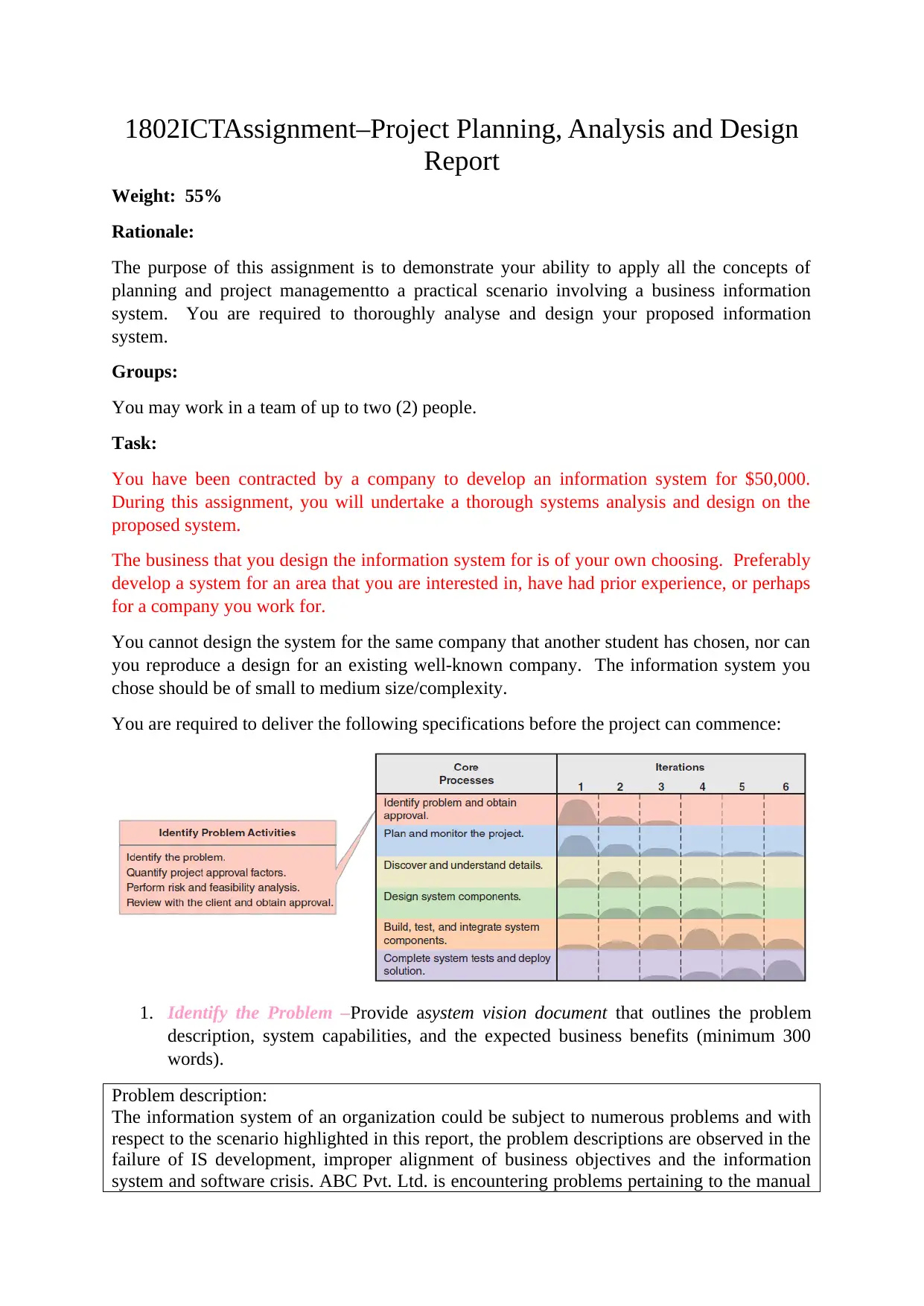
1802ICTAssignment–Project Planning, Analysis and Design
Report
Weight: 55%
Rationale:
The purpose of this assignment is to demonstrate your ability to apply all the concepts of
planning and project managementto a practical scenario involving a business information
system. You are required to thoroughly analyse and design your proposed information
system.
Groups:
You may work in a team of up to two (2) people.
Task:
You have been contracted by a company to develop an information system for $50,000.
During this assignment, you will undertake a thorough systems analysis and design on the
proposed system.
The business that you design the information system for is of your own choosing. Preferably
develop a system for an area that you are interested in, have had prior experience, or perhaps
for a company you work for.
You cannot design the system for the same company that another student has chosen, nor can
you reproduce a design for an existing well-known company. The information system you
chose should be of small to medium size/complexity.
You are required to deliver the following specifications before the project can commence:
1. Identify the Problem –Provide asystem vision document that outlines the problem
description, system capabilities, and the expected business benefits (minimum 300
words).
Problem description:
The information system of an organization could be subject to numerous problems and with
respect to the scenario highlighted in this report, the problem descriptions are observed in the
failure of IS development, improper alignment of business objectives and the information
system and software crisis. ABC Pvt. Ltd. is encountering problems pertaining to the manual
Report
Weight: 55%
Rationale:
The purpose of this assignment is to demonstrate your ability to apply all the concepts of
planning and project managementto a practical scenario involving a business information
system. You are required to thoroughly analyse and design your proposed information
system.
Groups:
You may work in a team of up to two (2) people.
Task:
You have been contracted by a company to develop an information system for $50,000.
During this assignment, you will undertake a thorough systems analysis and design on the
proposed system.
The business that you design the information system for is of your own choosing. Preferably
develop a system for an area that you are interested in, have had prior experience, or perhaps
for a company you work for.
You cannot design the system for the same company that another student has chosen, nor can
you reproduce a design for an existing well-known company. The information system you
chose should be of small to medium size/complexity.
You are required to deliver the following specifications before the project can commence:
1. Identify the Problem –Provide asystem vision document that outlines the problem
description, system capabilities, and the expected business benefits (minimum 300
words).
Problem description:
The information system of an organization could be subject to numerous problems and with
respect to the scenario highlighted in this report, the problem descriptions are observed in the
failure of IS development, improper alignment of business objectives and the information
system and software crisis. ABC Pvt. Ltd. is encountering problems pertaining to the manual
Paraphrase This Document
Need a fresh take? Get an instant paraphrase of this document with our AI Paraphraser
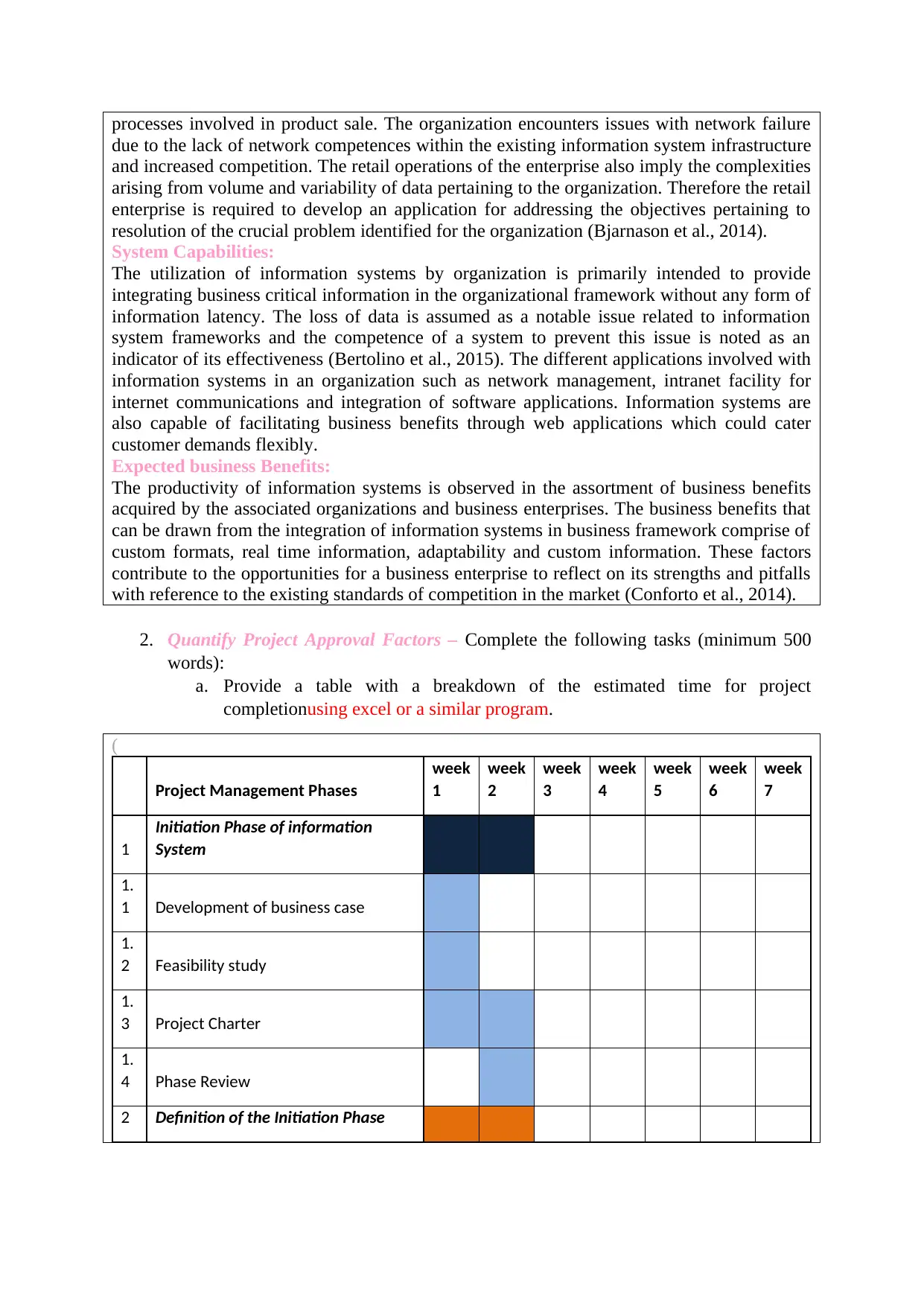
processes involved in product sale. The organization encounters issues with network failure
due to the lack of network competences within the existing information system infrastructure
and increased competition. The retail operations of the enterprise also imply the complexities
arising from volume and variability of data pertaining to the organization. Therefore the retail
enterprise is required to develop an application for addressing the objectives pertaining to
resolution of the crucial problem identified for the organization (Bjarnason et al., 2014).
System Capabilities:
The utilization of information systems by organization is primarily intended to provide
integrating business critical information in the organizational framework without any form of
information latency. The loss of data is assumed as a notable issue related to information
system frameworks and the competence of a system to prevent this issue is noted as an
indicator of its effectiveness (Bertolino et al., 2015). The different applications involved with
information systems in an organization such as network management, intranet facility for
internet communications and integration of software applications. Information systems are
also capable of facilitating business benefits through web applications which could cater
customer demands flexibly.
Expected business Benefits:
The productivity of information systems is observed in the assortment of business benefits
acquired by the associated organizations and business enterprises. The business benefits that
can be drawn from the integration of information systems in business framework comprise of
custom formats, real time information, adaptability and custom information. These factors
contribute to the opportunities for a business enterprise to reflect on its strengths and pitfalls
with reference to the existing standards of competition in the market (Conforto et al., 2014).
2. Quantify Project Approval Factors – Complete the following tasks (minimum 500
words):
a. Provide a table with a breakdown of the estimated time for project
completionusing excel or a similar program.
(
Project Management Phases
week
1
week
2
week
3
week
4
week
5
week
6
week
7
1
Initiation Phase of information
System
1.
1 Development of business case
1.
2 Feasibility study
1.
3 Project Charter
1.
4 Phase Review
2 Definition of the Initiation Phase
due to the lack of network competences within the existing information system infrastructure
and increased competition. The retail operations of the enterprise also imply the complexities
arising from volume and variability of data pertaining to the organization. Therefore the retail
enterprise is required to develop an application for addressing the objectives pertaining to
resolution of the crucial problem identified for the organization (Bjarnason et al., 2014).
System Capabilities:
The utilization of information systems by organization is primarily intended to provide
integrating business critical information in the organizational framework without any form of
information latency. The loss of data is assumed as a notable issue related to information
system frameworks and the competence of a system to prevent this issue is noted as an
indicator of its effectiveness (Bertolino et al., 2015). The different applications involved with
information systems in an organization such as network management, intranet facility for
internet communications and integration of software applications. Information systems are
also capable of facilitating business benefits through web applications which could cater
customer demands flexibly.
Expected business Benefits:
The productivity of information systems is observed in the assortment of business benefits
acquired by the associated organizations and business enterprises. The business benefits that
can be drawn from the integration of information systems in business framework comprise of
custom formats, real time information, adaptability and custom information. These factors
contribute to the opportunities for a business enterprise to reflect on its strengths and pitfalls
with reference to the existing standards of competition in the market (Conforto et al., 2014).
2. Quantify Project Approval Factors – Complete the following tasks (minimum 500
words):
a. Provide a table with a breakdown of the estimated time for project
completionusing excel or a similar program.
(
Project Management Phases
week
1
week
2
week
3
week
4
week
5
week
6
week
7
1
Initiation Phase of information
System
1.
1 Development of business case
1.
2 Feasibility study
1.
3 Project Charter
1.
4 Phase Review
2 Definition of the Initiation Phase
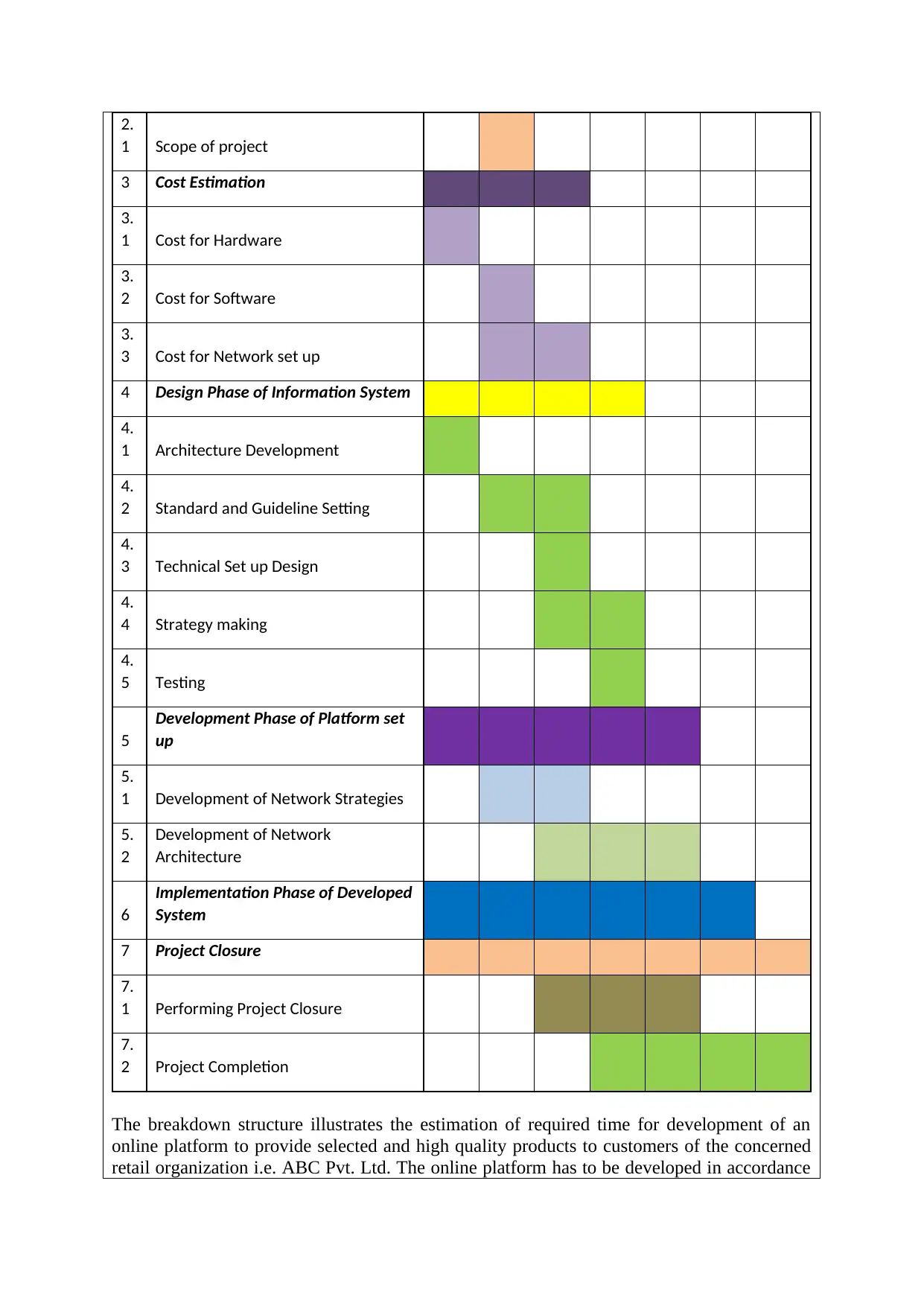
2.
1 Scope of project
3 Cost Estimation
3.
1 Cost for Hardware
3.
2 Cost for Software
3.
3 Cost for Network set up
4 Design Phase of Information System
4.
1 Architecture Development
4.
2 Standard and Guideline Setting
4.
3 Technical Set up Design
4.
4 Strategy making
4.
5 Testing
5
Development Phase of Platform set
up
5.
1 Development of Network Strategies
5.
2
Development of Network
Architecture
6
Implementation Phase of Developed
System
7 Project Closure
7.
1 Performing Project Closure
7.
2 Project Completion
The breakdown structure illustrates the estimation of required time for development of an
online platform to provide selected and high quality products to customers of the concerned
retail organization i.e. ABC Pvt. Ltd. The online platform has to be developed in accordance
1 Scope of project
3 Cost Estimation
3.
1 Cost for Hardware
3.
2 Cost for Software
3.
3 Cost for Network set up
4 Design Phase of Information System
4.
1 Architecture Development
4.
2 Standard and Guideline Setting
4.
3 Technical Set up Design
4.
4 Strategy making
4.
5 Testing
5
Development Phase of Platform set
up
5.
1 Development of Network Strategies
5.
2
Development of Network
Architecture
6
Implementation Phase of Developed
System
7 Project Closure
7.
1 Performing Project Closure
7.
2 Project Completion
The breakdown structure illustrates the estimation of required time for development of an
online platform to provide selected and high quality products to customers of the concerned
retail organization i.e. ABC Pvt. Ltd. The online platform has to be developed in accordance
⊘ This is a preview!⊘
Do you want full access?
Subscribe today to unlock all pages.

Trusted by 1+ million students worldwide
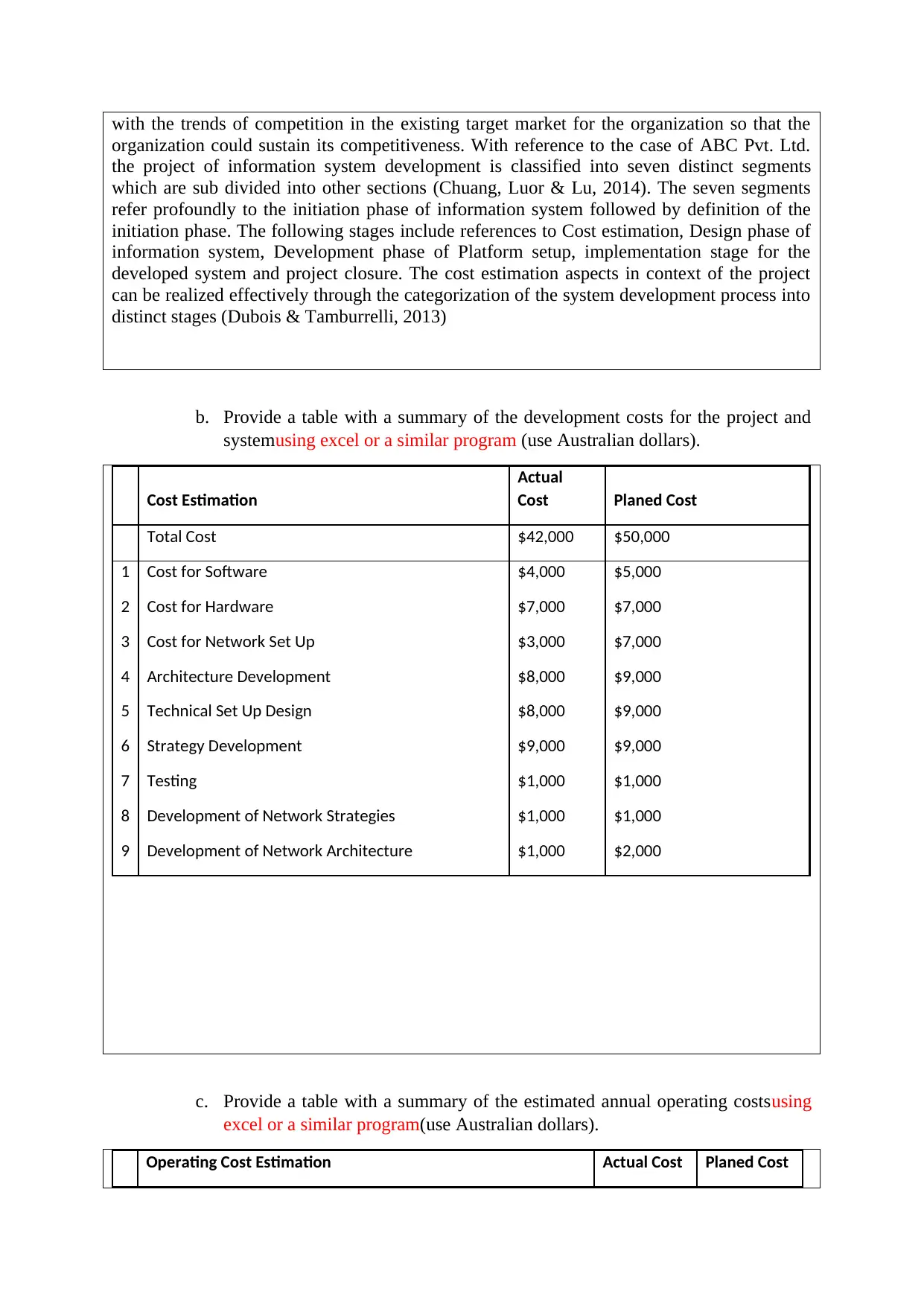
with the trends of competition in the existing target market for the organization so that the
organization could sustain its competitiveness. With reference to the case of ABC Pvt. Ltd.
the project of information system development is classified into seven distinct segments
which are sub divided into other sections (Chuang, Luor & Lu, 2014). The seven segments
refer profoundly to the initiation phase of information system followed by definition of the
initiation phase. The following stages include references to Cost estimation, Design phase of
information system, Development phase of Platform setup, implementation stage for the
developed system and project closure. The cost estimation aspects in context of the project
can be realized effectively through the categorization of the system development process into
distinct stages (Dubois & Tamburrelli, 2013)
b. Provide a table with a summary of the development costs for the project and
systemusing excel or a similar program (use Australian dollars).
Cost Estimation
Actual
Cost Planed Cost
Total Cost $42,000 $50,000
1 Cost for Software $4,000 $5,000
2 Cost for Hardware $7,000 $7,000
3 Cost for Network Set Up $3,000 $7,000
4 Architecture Development $8,000 $9,000
5 Technical Set Up Design $8,000 $9,000
6 Strategy Development $9,000 $9,000
7 Testing $1,000 $1,000
8 Development of Network Strategies $1,000 $1,000
9 Development of Network Architecture $1,000 $2,000
c. Provide a table with a summary of the estimated annual operating costsusing
excel or a similar program(use Australian dollars).
Operating Cost Estimation Actual Cost Planed Cost
organization could sustain its competitiveness. With reference to the case of ABC Pvt. Ltd.
the project of information system development is classified into seven distinct segments
which are sub divided into other sections (Chuang, Luor & Lu, 2014). The seven segments
refer profoundly to the initiation phase of information system followed by definition of the
initiation phase. The following stages include references to Cost estimation, Design phase of
information system, Development phase of Platform setup, implementation stage for the
developed system and project closure. The cost estimation aspects in context of the project
can be realized effectively through the categorization of the system development process into
distinct stages (Dubois & Tamburrelli, 2013)
b. Provide a table with a summary of the development costs for the project and
systemusing excel or a similar program (use Australian dollars).
Cost Estimation
Actual
Cost Planed Cost
Total Cost $42,000 $50,000
1 Cost for Software $4,000 $5,000
2 Cost for Hardware $7,000 $7,000
3 Cost for Network Set Up $3,000 $7,000
4 Architecture Development $8,000 $9,000
5 Technical Set Up Design $8,000 $9,000
6 Strategy Development $9,000 $9,000
7 Testing $1,000 $1,000
8 Development of Network Strategies $1,000 $1,000
9 Development of Network Architecture $1,000 $2,000
c. Provide a table with a summary of the estimated annual operating costsusing
excel or a similar program(use Australian dollars).
Operating Cost Estimation Actual Cost Planed Cost
Paraphrase This Document
Need a fresh take? Get an instant paraphrase of this document with our AI Paraphraser
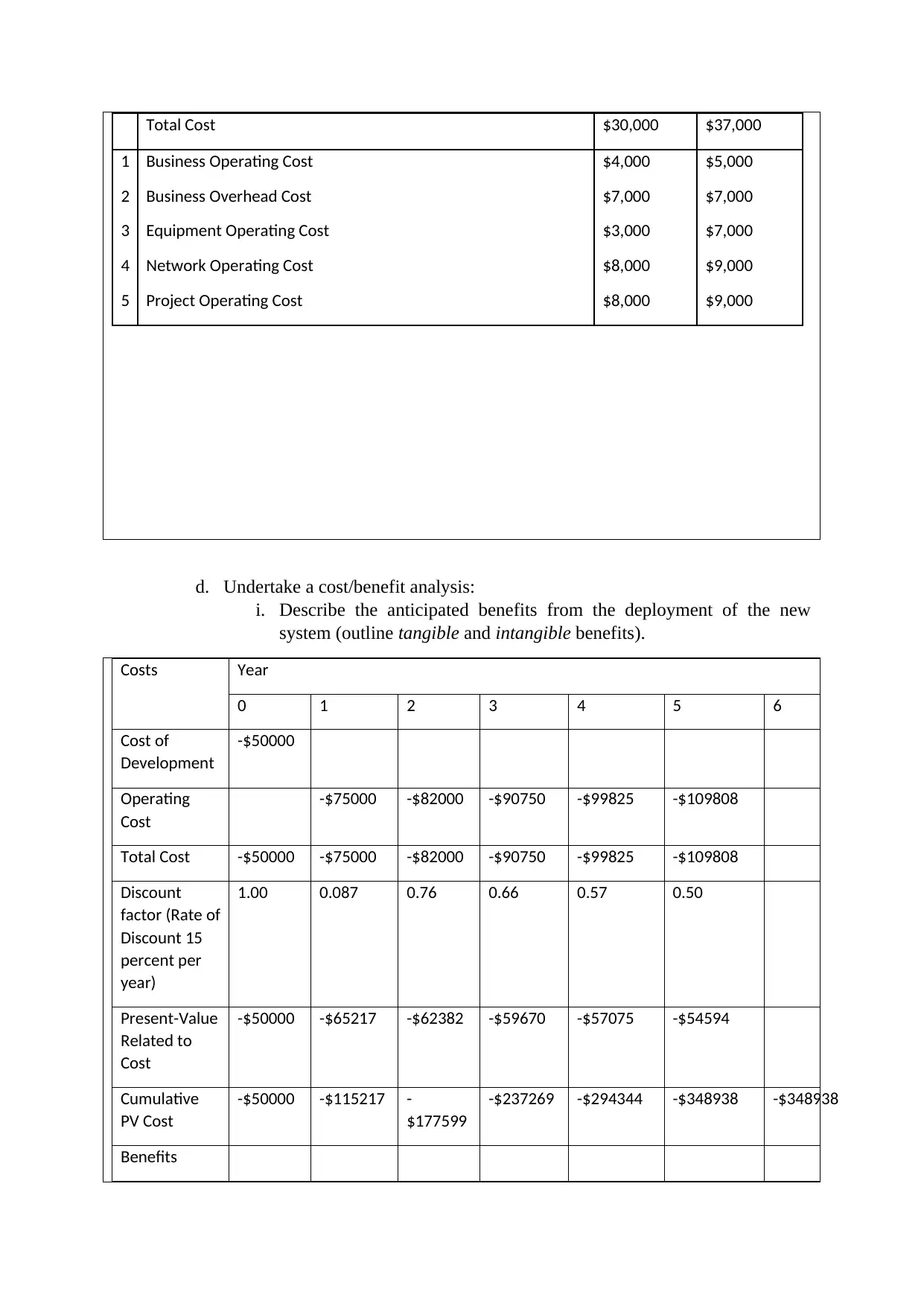
Total Cost $30,000 $37,000
1 Business Operating Cost $4,000 $5,000
2 Business Overhead Cost $7,000 $7,000
3 Equipment Operating Cost $3,000 $7,000
4 Network Operating Cost $8,000 $9,000
5 Project Operating Cost $8,000 $9,000
d. Undertake a cost/benefit analysis:
i. Describe the anticipated benefits from the deployment of the new
system (outline tangible and intangible benefits).
Costs Year
0 1 2 3 4 5 6
Cost of
Development
-$50000
Operating
Cost
-$75000 -$82000 -$90750 -$99825 -$109808
Total Cost -$50000 -$75000 -$82000 -$90750 -$99825 -$109808
Discount
factor (Rate of
Discount 15
percent per
year)
1.00 0.087 0.76 0.66 0.57 0.50
Present-Value
Related to
Cost
-$50000 -$65217 -$62382 -$59670 -$57075 -$54594
Cumulative
PV Cost
-$50000 -$115217 -
$177599
-$237269 -$294344 -$348938 -$348938
Benefits
1 Business Operating Cost $4,000 $5,000
2 Business Overhead Cost $7,000 $7,000
3 Equipment Operating Cost $3,000 $7,000
4 Network Operating Cost $8,000 $9,000
5 Project Operating Cost $8,000 $9,000
d. Undertake a cost/benefit analysis:
i. Describe the anticipated benefits from the deployment of the new
system (outline tangible and intangible benefits).
Costs Year
0 1 2 3 4 5 6
Cost of
Development
-$50000
Operating
Cost
-$75000 -$82000 -$90750 -$99825 -$109808
Total Cost -$50000 -$75000 -$82000 -$90750 -$99825 -$109808
Discount
factor (Rate of
Discount 15
percent per
year)
1.00 0.087 0.76 0.66 0.57 0.50
Present-Value
Related to
Cost
-$50000 -$65217 -$62382 -$59670 -$57075 -$54594
Cumulative
PV Cost
-$50000 -$115217 -
$177599
-$237269 -$294344 -$348938 -$348938
Benefits
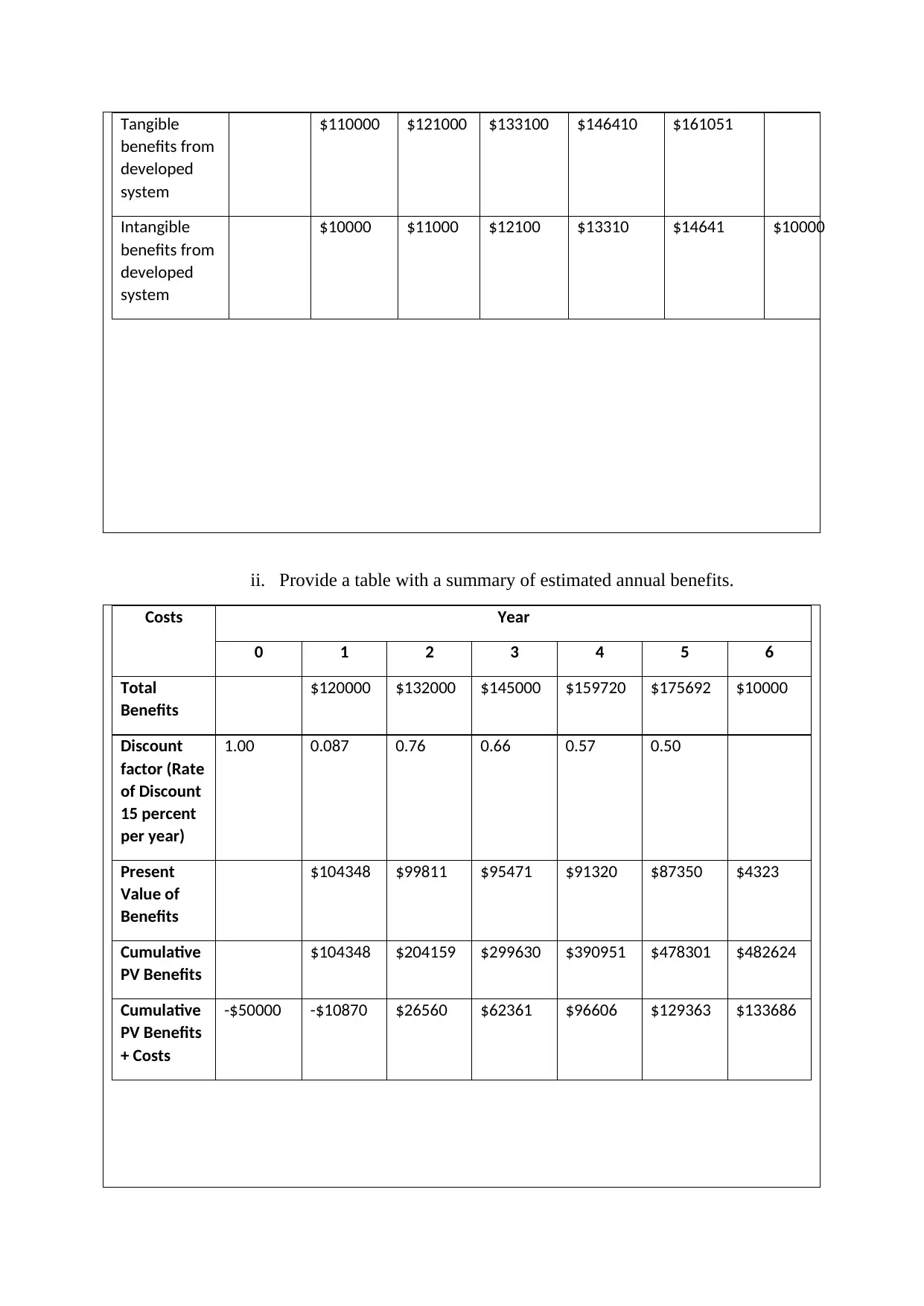
Tangible
benefits from
developed
system
$110000 $121000 $133100 $146410 $161051
Intangible
benefits from
developed
system
$10000 $11000 $12100 $13310 $14641 $10000
ii. Provide a table with a summary of estimated annual benefits.
Costs Year
0 1 2 3 4 5 6
Total
Benefits
$120000 $132000 $145000 $159720 $175692 $10000
Discount
factor (Rate
of Discount
15 percent
per year)
1.00 0.087 0.76 0.66 0.57 0.50
Present
Value of
Benefits
$104348 $99811 $95471 $91320 $87350 $4323
Cumulative
PV Benefits
$104348 $204159 $299630 $390951 $478301 $482624
Cumulative
PV Benefits
+ Costs
-$50000 -$10870 $26560 $62361 $96606 $129363 $133686
benefits from
developed
system
$110000 $121000 $133100 $146410 $161051
Intangible
benefits from
developed
system
$10000 $11000 $12100 $13310 $14641 $10000
ii. Provide a table with a summary of estimated annual benefits.
Costs Year
0 1 2 3 4 5 6
Total
Benefits
$120000 $132000 $145000 $159720 $175692 $10000
Discount
factor (Rate
of Discount
15 percent
per year)
1.00 0.087 0.76 0.66 0.57 0.50
Present
Value of
Benefits
$104348 $99811 $95471 $91320 $87350 $4323
Cumulative
PV Benefits
$104348 $204159 $299630 $390951 $478301 $482624
Cumulative
PV Benefits
+ Costs
-$50000 -$10870 $26560 $62361 $96606 $129363 $133686
⊘ This is a preview!⊘
Do you want full access?
Subscribe today to unlock all pages.

Trusted by 1+ million students worldwide
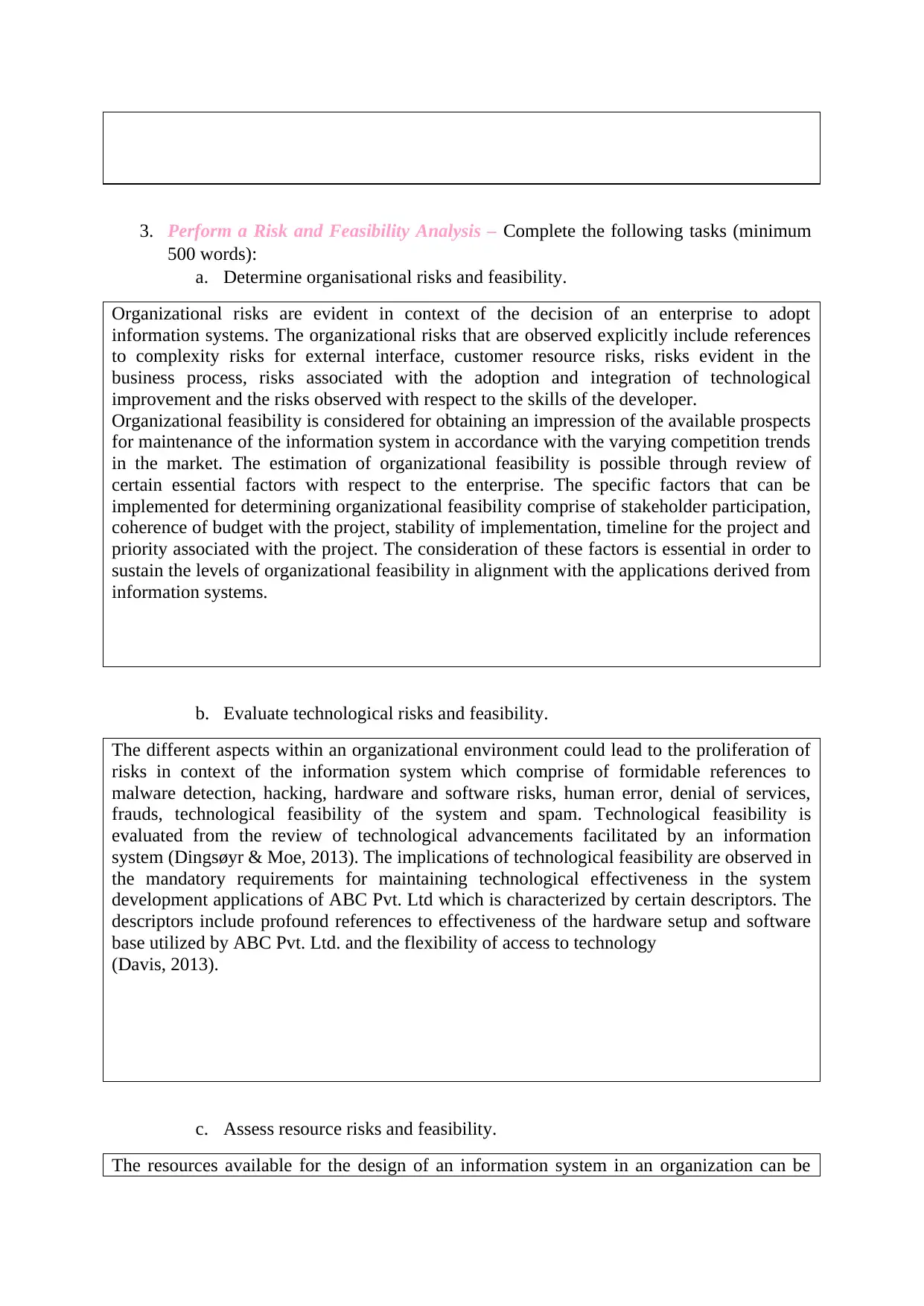
3. Perform a Risk and Feasibility Analysis – Complete the following tasks (minimum
500 words):
a. Determine organisational risks and feasibility.
Organizational risks are evident in context of the decision of an enterprise to adopt
information systems. The organizational risks that are observed explicitly include references
to complexity risks for external interface, customer resource risks, risks evident in the
business process, risks associated with the adoption and integration of technological
improvement and the risks observed with respect to the skills of the developer.
Organizational feasibility is considered for obtaining an impression of the available prospects
for maintenance of the information system in accordance with the varying competition trends
in the market. The estimation of organizational feasibility is possible through review of
certain essential factors with respect to the enterprise. The specific factors that can be
implemented for determining organizational feasibility comprise of stakeholder participation,
coherence of budget with the project, stability of implementation, timeline for the project and
priority associated with the project. The consideration of these factors is essential in order to
sustain the levels of organizational feasibility in alignment with the applications derived from
information systems.
b. Evaluate technological risks and feasibility.
The different aspects within an organizational environment could lead to the proliferation of
risks in context of the information system which comprise of formidable references to
malware detection, hacking, hardware and software risks, human error, denial of services,
frauds, technological feasibility of the system and spam. Technological feasibility is
evaluated from the review of technological advancements facilitated by an information
system (Dingsøyr & Moe, 2013). The implications of technological feasibility are observed in
the mandatory requirements for maintaining technological effectiveness in the system
development applications of ABC Pvt. Ltd which is characterized by certain descriptors. The
descriptors include profound references to effectiveness of the hardware setup and software
base utilized by ABC Pvt. Ltd. and the flexibility of access to technology
(Davis, 2013).
c. Assess resource risks and feasibility.
The resources available for the design of an information system in an organization can be
500 words):
a. Determine organisational risks and feasibility.
Organizational risks are evident in context of the decision of an enterprise to adopt
information systems. The organizational risks that are observed explicitly include references
to complexity risks for external interface, customer resource risks, risks evident in the
business process, risks associated with the adoption and integration of technological
improvement and the risks observed with respect to the skills of the developer.
Organizational feasibility is considered for obtaining an impression of the available prospects
for maintenance of the information system in accordance with the varying competition trends
in the market. The estimation of organizational feasibility is possible through review of
certain essential factors with respect to the enterprise. The specific factors that can be
implemented for determining organizational feasibility comprise of stakeholder participation,
coherence of budget with the project, stability of implementation, timeline for the project and
priority associated with the project. The consideration of these factors is essential in order to
sustain the levels of organizational feasibility in alignment with the applications derived from
information systems.
b. Evaluate technological risks and feasibility.
The different aspects within an organizational environment could lead to the proliferation of
risks in context of the information system which comprise of formidable references to
malware detection, hacking, hardware and software risks, human error, denial of services,
frauds, technological feasibility of the system and spam. Technological feasibility is
evaluated from the review of technological advancements facilitated by an information
system (Dingsøyr & Moe, 2013). The implications of technological feasibility are observed in
the mandatory requirements for maintaining technological effectiveness in the system
development applications of ABC Pvt. Ltd which is characterized by certain descriptors. The
descriptors include profound references to effectiveness of the hardware setup and software
base utilized by ABC Pvt. Ltd. and the flexibility of access to technology
(Davis, 2013).
c. Assess resource risks and feasibility.
The resources available for the design of an information system in an organization can be
Paraphrase This Document
Need a fresh take? Get an instant paraphrase of this document with our AI Paraphraser
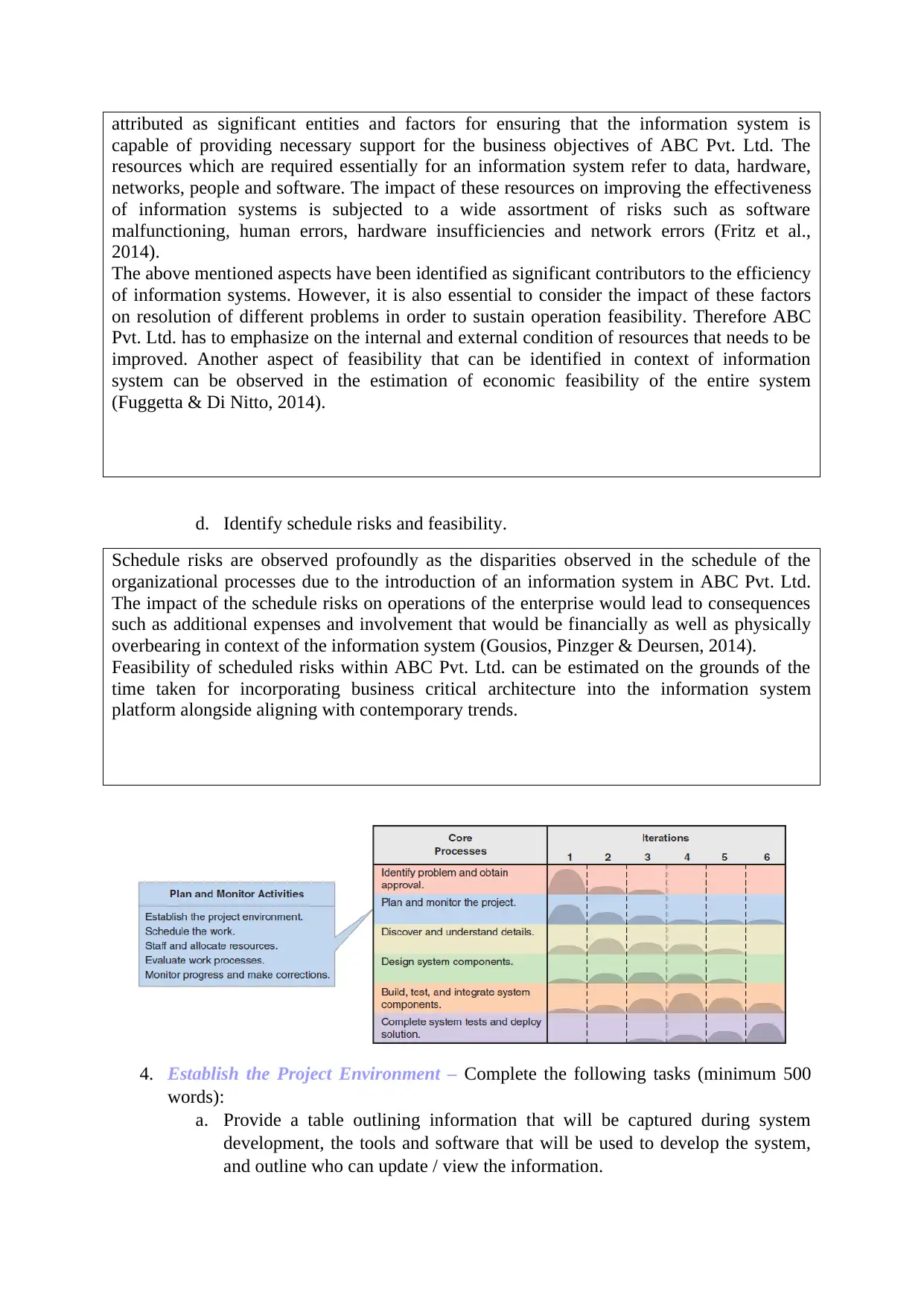
attributed as significant entities and factors for ensuring that the information system is
capable of providing necessary support for the business objectives of ABC Pvt. Ltd. The
resources which are required essentially for an information system refer to data, hardware,
networks, people and software. The impact of these resources on improving the effectiveness
of information systems is subjected to a wide assortment of risks such as software
malfunctioning, human errors, hardware insufficiencies and network errors (Fritz et al.,
2014).
The above mentioned aspects have been identified as significant contributors to the efficiency
of information systems. However, it is also essential to consider the impact of these factors
on resolution of different problems in order to sustain operation feasibility. Therefore ABC
Pvt. Ltd. has to emphasize on the internal and external condition of resources that needs to be
improved. Another aspect of feasibility that can be identified in context of information
system can be observed in the estimation of economic feasibility of the entire system
(Fuggetta & Di Nitto, 2014).
d. Identify schedule risks and feasibility.
Schedule risks are observed profoundly as the disparities observed in the schedule of the
organizational processes due to the introduction of an information system in ABC Pvt. Ltd.
The impact of the schedule risks on operations of the enterprise would lead to consequences
such as additional expenses and involvement that would be financially as well as physically
overbearing in context of the information system (Gousios, Pinzger & Deursen, 2014).
Feasibility of scheduled risks within ABC Pvt. Ltd. can be estimated on the grounds of the
time taken for incorporating business critical architecture into the information system
platform alongside aligning with contemporary trends.
4. Establish the Project Environment – Complete the following tasks (minimum 500
words):
a. Provide a table outlining information that will be captured during system
development, the tools and software that will be used to develop the system,
and outline who can update / view the information.
capable of providing necessary support for the business objectives of ABC Pvt. Ltd. The
resources which are required essentially for an information system refer to data, hardware,
networks, people and software. The impact of these resources on improving the effectiveness
of information systems is subjected to a wide assortment of risks such as software
malfunctioning, human errors, hardware insufficiencies and network errors (Fritz et al.,
2014).
The above mentioned aspects have been identified as significant contributors to the efficiency
of information systems. However, it is also essential to consider the impact of these factors
on resolution of different problems in order to sustain operation feasibility. Therefore ABC
Pvt. Ltd. has to emphasize on the internal and external condition of resources that needs to be
improved. Another aspect of feasibility that can be identified in context of information
system can be observed in the estimation of economic feasibility of the entire system
(Fuggetta & Di Nitto, 2014).
d. Identify schedule risks and feasibility.
Schedule risks are observed profoundly as the disparities observed in the schedule of the
organizational processes due to the introduction of an information system in ABC Pvt. Ltd.
The impact of the schedule risks on operations of the enterprise would lead to consequences
such as additional expenses and involvement that would be financially as well as physically
overbearing in context of the information system (Gousios, Pinzger & Deursen, 2014).
Feasibility of scheduled risks within ABC Pvt. Ltd. can be estimated on the grounds of the
time taken for incorporating business critical architecture into the information system
platform alongside aligning with contemporary trends.
4. Establish the Project Environment – Complete the following tasks (minimum 500
words):
a. Provide a table outlining information that will be captured during system
development, the tools and software that will be used to develop the system,
and outline who can update / view the information.
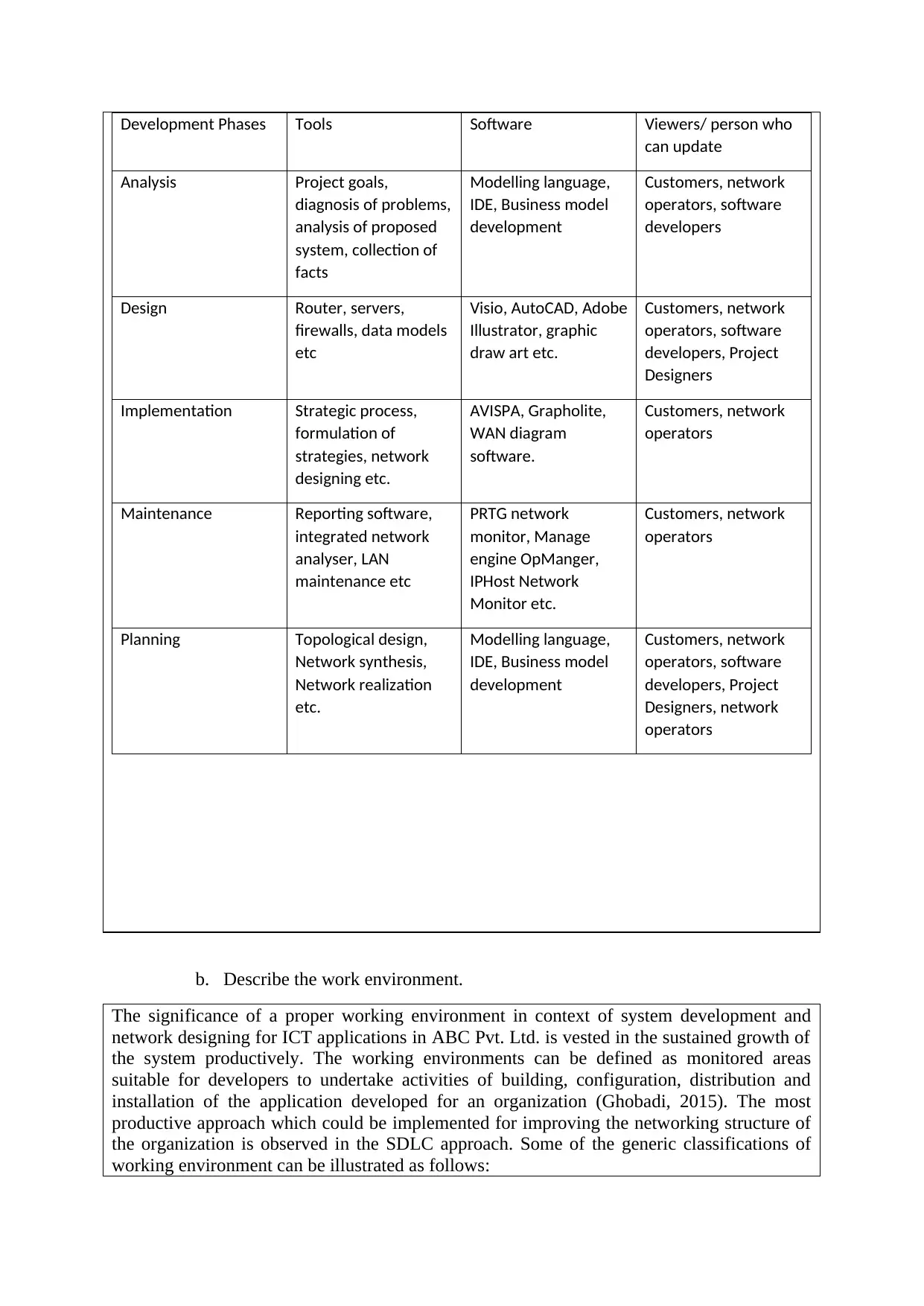
Development Phases Tools Software Viewers/ person who
can update
Analysis Project goals,
diagnosis of problems,
analysis of proposed
system, collection of
facts
Modelling language,
IDE, Business model
development
Customers, network
operators, software
developers
Design Router, servers,
firewalls, data models
etc
Visio, AutoCAD, Adobe
Illustrator, graphic
draw art etc.
Customers, network
operators, software
developers, Project
Designers
Implementation Strategic process,
formulation of
strategies, network
designing etc.
AVISPA, Grapholite,
WAN diagram
software.
Customers, network
operators
Maintenance Reporting software,
integrated network
analyser, LAN
maintenance etc
PRTG network
monitor, Manage
engine OpManger,
IPHost Network
Monitor etc.
Customers, network
operators
Planning Topological design,
Network synthesis,
Network realization
etc.
Modelling language,
IDE, Business model
development
Customers, network
operators, software
developers, Project
Designers, network
operators
b. Describe the work environment.
The significance of a proper working environment in context of system development and
network designing for ICT applications in ABC Pvt. Ltd. is vested in the sustained growth of
the system productively. The working environments can be defined as monitored areas
suitable for developers to undertake activities of building, configuration, distribution and
installation of the application developed for an organization (Ghobadi, 2015). The most
productive approach which could be implemented for improving the networking structure of
the organization is observed in the SDLC approach. Some of the generic classifications of
working environment can be illustrated as follows:
can update
Analysis Project goals,
diagnosis of problems,
analysis of proposed
system, collection of
facts
Modelling language,
IDE, Business model
development
Customers, network
operators, software
developers
Design Router, servers,
firewalls, data models
etc
Visio, AutoCAD, Adobe
Illustrator, graphic
draw art etc.
Customers, network
operators, software
developers, Project
Designers
Implementation Strategic process,
formulation of
strategies, network
designing etc.
AVISPA, Grapholite,
WAN diagram
software.
Customers, network
operators
Maintenance Reporting software,
integrated network
analyser, LAN
maintenance etc
PRTG network
monitor, Manage
engine OpManger,
IPHost Network
Monitor etc.
Customers, network
operators
Planning Topological design,
Network synthesis,
Network realization
etc.
Modelling language,
IDE, Business model
development
Customers, network
operators, software
developers, Project
Designers, network
operators
b. Describe the work environment.
The significance of a proper working environment in context of system development and
network designing for ICT applications in ABC Pvt. Ltd. is vested in the sustained growth of
the system productively. The working environments can be defined as monitored areas
suitable for developers to undertake activities of building, configuration, distribution and
installation of the application developed for an organization (Ghobadi, 2015). The most
productive approach which could be implemented for improving the networking structure of
the organization is observed in the SDLC approach. Some of the generic classifications of
working environment can be illustrated as follows:
⊘ This is a preview!⊘
Do you want full access?
Subscribe today to unlock all pages.

Trusted by 1+ million students worldwide
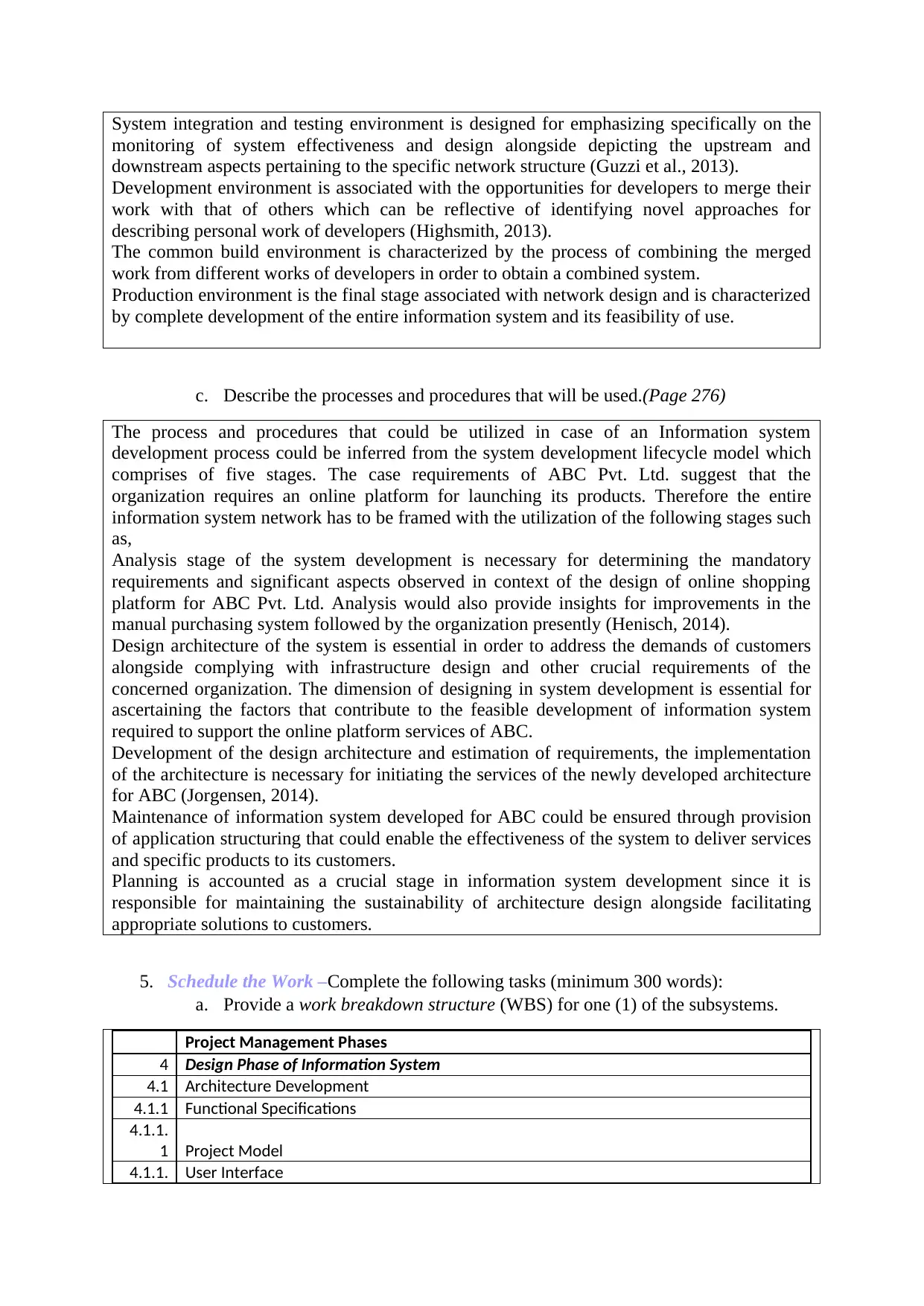
System integration and testing environment is designed for emphasizing specifically on the
monitoring of system effectiveness and design alongside depicting the upstream and
downstream aspects pertaining to the specific network structure (Guzzi et al., 2013).
Development environment is associated with the opportunities for developers to merge their
work with that of others which can be reflective of identifying novel approaches for
describing personal work of developers (Highsmith, 2013).
The common build environment is characterized by the process of combining the merged
work from different works of developers in order to obtain a combined system.
Production environment is the final stage associated with network design and is characterized
by complete development of the entire information system and its feasibility of use.
c. Describe the processes and procedures that will be used.(Page 276)
The process and procedures that could be utilized in case of an Information system
development process could be inferred from the system development lifecycle model which
comprises of five stages. The case requirements of ABC Pvt. Ltd. suggest that the
organization requires an online platform for launching its products. Therefore the entire
information system network has to be framed with the utilization of the following stages such
as,
Analysis stage of the system development is necessary for determining the mandatory
requirements and significant aspects observed in context of the design of online shopping
platform for ABC Pvt. Ltd. Analysis would also provide insights for improvements in the
manual purchasing system followed by the organization presently (Henisch, 2014).
Design architecture of the system is essential in order to address the demands of customers
alongside complying with infrastructure design and other crucial requirements of the
concerned organization. The dimension of designing in system development is essential for
ascertaining the factors that contribute to the feasible development of information system
required to support the online platform services of ABC.
Development of the design architecture and estimation of requirements, the implementation
of the architecture is necessary for initiating the services of the newly developed architecture
for ABC (Jorgensen, 2014).
Maintenance of information system developed for ABC could be ensured through provision
of application structuring that could enable the effectiveness of the system to deliver services
and specific products to its customers.
Planning is accounted as a crucial stage in information system development since it is
responsible for maintaining the sustainability of architecture design alongside facilitating
appropriate solutions to customers.
5. Schedule the Work –Complete the following tasks (minimum 300 words):
a. Provide a work breakdown structure (WBS) for one (1) of the subsystems.
Project Management Phases
4 Design Phase of Information System
4.1 Architecture Development
4.1.1 Functional Specifications
4.1.1.
1 Project Model
4.1.1. User Interface
monitoring of system effectiveness and design alongside depicting the upstream and
downstream aspects pertaining to the specific network structure (Guzzi et al., 2013).
Development environment is associated with the opportunities for developers to merge their
work with that of others which can be reflective of identifying novel approaches for
describing personal work of developers (Highsmith, 2013).
The common build environment is characterized by the process of combining the merged
work from different works of developers in order to obtain a combined system.
Production environment is the final stage associated with network design and is characterized
by complete development of the entire information system and its feasibility of use.
c. Describe the processes and procedures that will be used.(Page 276)
The process and procedures that could be utilized in case of an Information system
development process could be inferred from the system development lifecycle model which
comprises of five stages. The case requirements of ABC Pvt. Ltd. suggest that the
organization requires an online platform for launching its products. Therefore the entire
information system network has to be framed with the utilization of the following stages such
as,
Analysis stage of the system development is necessary for determining the mandatory
requirements and significant aspects observed in context of the design of online shopping
platform for ABC Pvt. Ltd. Analysis would also provide insights for improvements in the
manual purchasing system followed by the organization presently (Henisch, 2014).
Design architecture of the system is essential in order to address the demands of customers
alongside complying with infrastructure design and other crucial requirements of the
concerned organization. The dimension of designing in system development is essential for
ascertaining the factors that contribute to the feasible development of information system
required to support the online platform services of ABC.
Development of the design architecture and estimation of requirements, the implementation
of the architecture is necessary for initiating the services of the newly developed architecture
for ABC (Jorgensen, 2014).
Maintenance of information system developed for ABC could be ensured through provision
of application structuring that could enable the effectiveness of the system to deliver services
and specific products to its customers.
Planning is accounted as a crucial stage in information system development since it is
responsible for maintaining the sustainability of architecture design alongside facilitating
appropriate solutions to customers.
5. Schedule the Work –Complete the following tasks (minimum 300 words):
a. Provide a work breakdown structure (WBS) for one (1) of the subsystems.
Project Management Phases
4 Design Phase of Information System
4.1 Architecture Development
4.1.1 Functional Specifications
4.1.1.
1 Project Model
4.1.1. User Interface
Paraphrase This Document
Need a fresh take? Get an instant paraphrase of this document with our AI Paraphraser
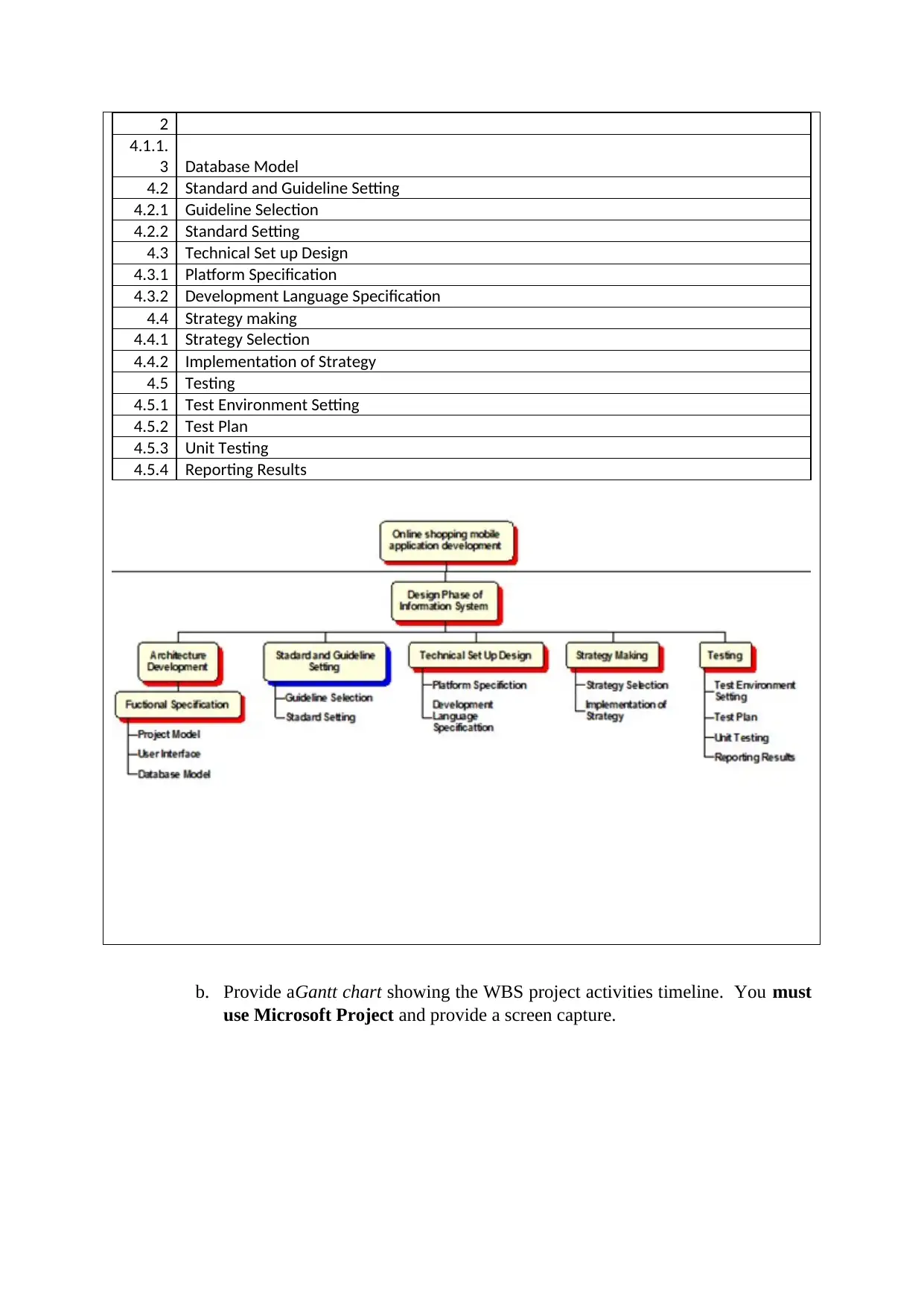
2
4.1.1.
3 Database Model
4.2 Standard and Guideline Setting
4.2.1 Guideline Selection
4.2.2 Standard Setting
4.3 Technical Set up Design
4.3.1 Platform Specification
4.3.2 Development Language Specification
4.4 Strategy making
4.4.1 Strategy Selection
4.4.2 Implementation of Strategy
4.5 Testing
4.5.1 Test Environment Setting
4.5.2 Test Plan
4.5.3 Unit Testing
4.5.4 Reporting Results
b. Provide aGantt chart showing the WBS project activities timeline. You must
use Microsoft Project and provide a screen capture.
4.1.1.
3 Database Model
4.2 Standard and Guideline Setting
4.2.1 Guideline Selection
4.2.2 Standard Setting
4.3 Technical Set up Design
4.3.1 Platform Specification
4.3.2 Development Language Specification
4.4 Strategy making
4.4.1 Strategy Selection
4.4.2 Implementation of Strategy
4.5 Testing
4.5.1 Test Environment Setting
4.5.2 Test Plan
4.5.3 Unit Testing
4.5.4 Reporting Results
b. Provide aGantt chart showing the WBS project activities timeline. You must
use Microsoft Project and provide a screen capture.
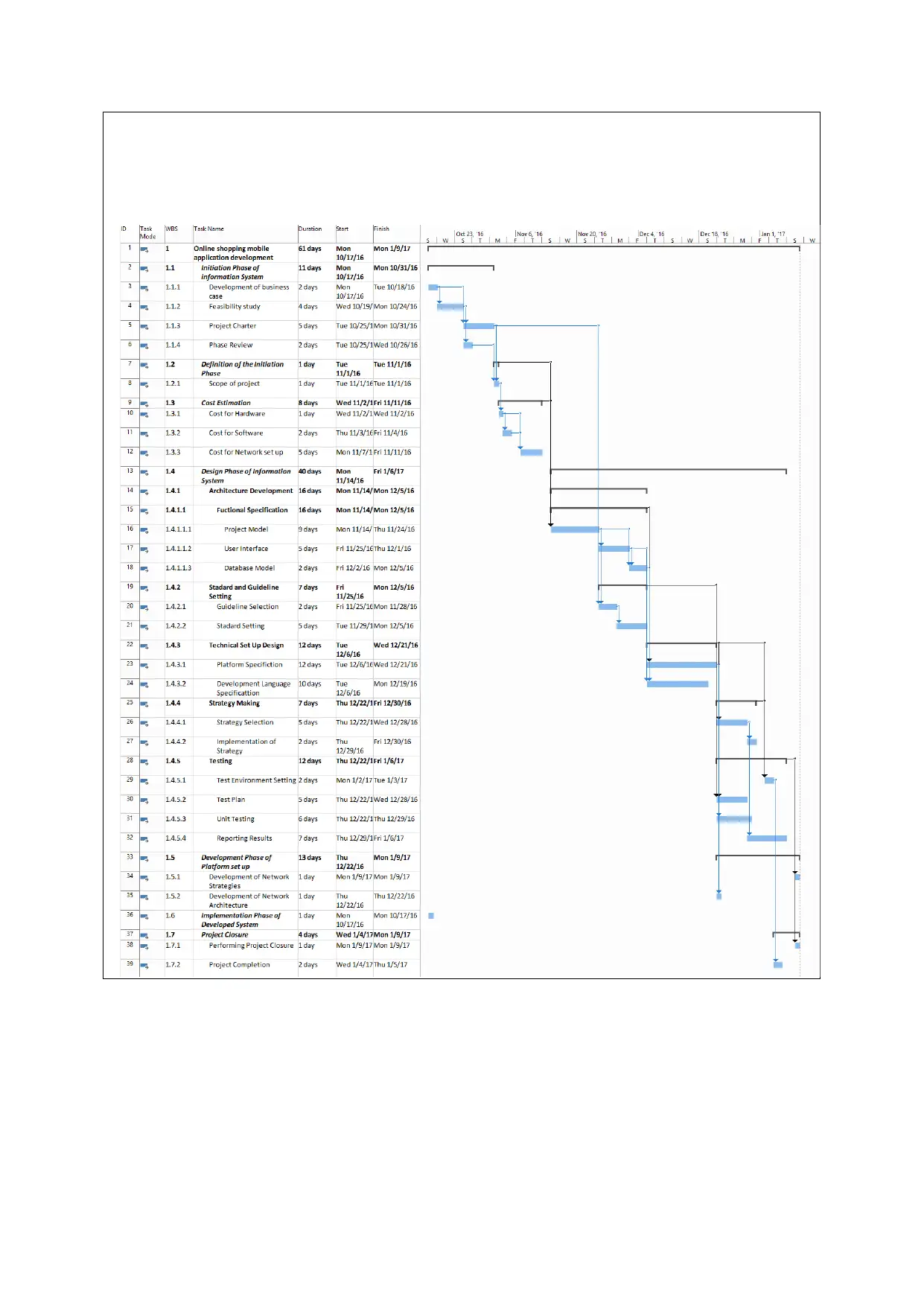
⊘ This is a preview!⊘
Do you want full access?
Subscribe today to unlock all pages.

Trusted by 1+ million students worldwide
1 out of 28
Related Documents
Your All-in-One AI-Powered Toolkit for Academic Success.
+13062052269
info@desklib.com
Available 24*7 on WhatsApp / Email
![[object Object]](/_next/static/media/star-bottom.7253800d.svg)
Unlock your academic potential
Copyright © 2020–2025 A2Z Services. All Rights Reserved. Developed and managed by ZUCOL.




